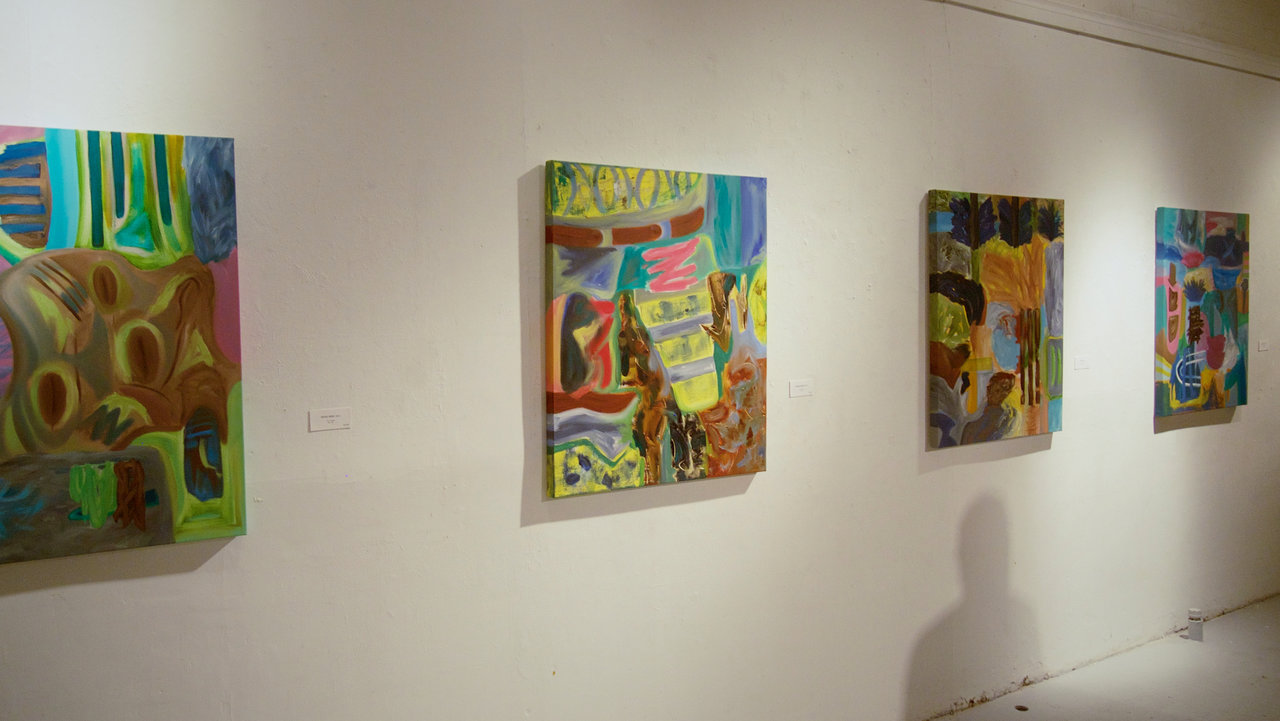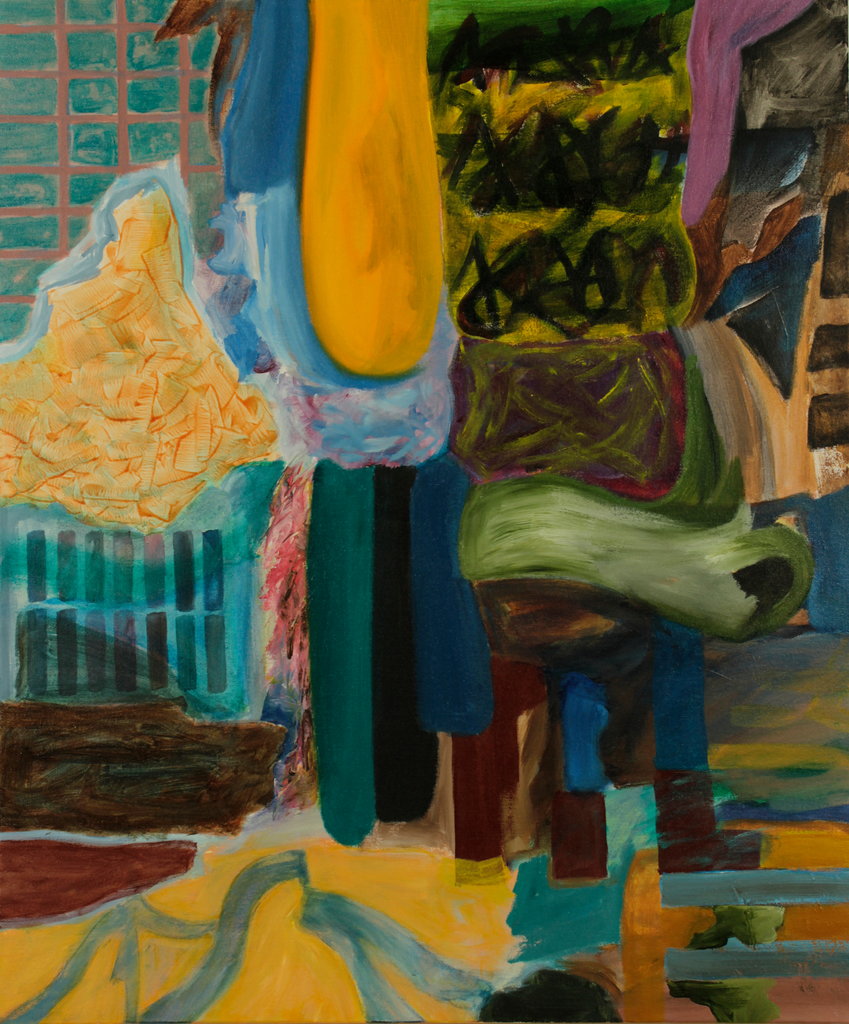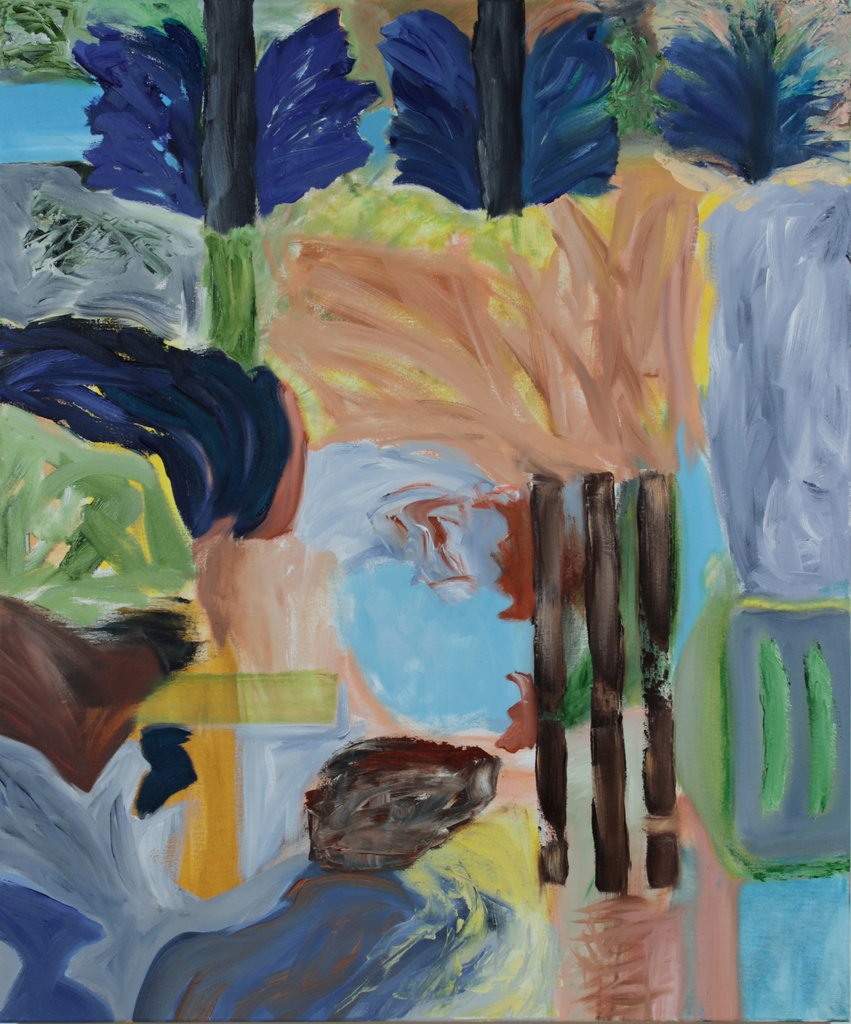Strong colors and powerful compositions greet me in Gallery 1313 at Imre Hajagos’ solo show, Cold Brew Horizon. All the paintings, some oil and some acrylic, are abstract. Being familiar with Hajagos’ past work, I see this show as a departure. It’s still abstract, there are still lines and urban imagery, but these paintings are more playful and suggest stories that are more accessible. It is also a departure as natural and organic forms play an equally important role as urban motifs. The artist contemplates subjects as diverse as the universe’s passage of time (“Mystic River”, 2015) all the way to the simple pleasure of the lakeside in “Splash”.
Hajagos’ approach toward his subject matter is always intellectual; there is nothing on the canvases that is not premeditated. He observes and thinks over his themes for a long time, reads books on topics that interest him, like quantum mechanics or microbiology, philosophy and contemporary literature. He doesn’t make sketches but has a clear idea about the painting before beginning. Then when actually painting it, through the physical act of “pushing the paint on the canvas”, the composition really takes form. The final work juxtaposes the intellectual and the physical and is full of energy.
 Installation view. Photo: Summer Sun
Installation view. Photo: Summer Sun
Everything was born from chaos, and this biblical chaos is seen throughout Hajagos’ paintings. However his compositions are a controlled mixture of the chaotic and the orderly. He points out that physics, especially quantum mechanics, proves that everything in the universe is orderly but unfortunately our limited understanding makes it look chaotic, so both chaos and order are always present in his paintings. Time is another major element of Hajagos’ work. According to universal time, a human life is very short – a mere blink — and that’s why it’s so special. We lose it so soon. “Mystic River” depicts elements of our evolution in the form of cells, sperm-like lines, and a large rock-like image of cell mitosis that dominates the surface along with a little embryonic creature. The river of endless time flows into eternity, carrying the basic elements of life toward an unknown future. While “Mystic River” focuses on biological time, “Writing on the Other Side” explores our intellectual lives. Different forms of writing like Egyptian hieroglyphics, sticks, knots, Chinese calligraphy and modern letters are mixed with human history, some forgotten but still present in our unconscious – they are just on the “other side”. In front of squares and blocks that remind us of computer memory panels, a large, delicately painted orange shape floats. A pyramid made of paper ribbons? And another orange shape like a monumental tear drop or a solar flare. The criss-crossed lines might be writings, mixed and overwritten, but no longer readable. Hajagos’ paintings are open to rich interpretation, but all the possible narratives are speculations by the viewer.
 Imre Hajagos, Writing on the Other Side, 2014, acrylic on canvas, 36″ x 30″. Courtesy of the artist
Imre Hajagos, Writing on the Other Side, 2014, acrylic on canvas, 36″ x 30″. Courtesy of the artist
Time is also movement and there’s lots of movement in Hajagos’ pieces. Looking at them, I was taken with the freedom they convey. While he paints he always listens to music, both “forceful and laid back”. The music is all about movement, bringing unexpected elements into the painting and, as the rhythms freely come and go, the motifs on the canvas flow with them. The strong rhythmical movement of the bright yellow light in “Solar Wind” or the cooler, blue light of the night in “Blue Moon Rising” resonate to music. You can almost hear the water in “Splash” as someone happily jumps into a pool. The trees in the background are depicted as they are in Egyptian wall paintings, highly stylized and ornamental. Tall grass bends in the breeze, rocks shimmer in the heat. The two human-like shapes in the foreground might be onlookers or maybe just abstract forms for the sake of the composition. Hard to figure out.
 Imre Hajagos, Splash, 2015, oil on canvas, 36″ x 30″. Courtesy of the artist
Imre Hajagos, Splash, 2015, oil on canvas, 36″ x 30″. Courtesy of the artist
Hajagos’ entire life has been spent in cosmopolitan cities with all the bliss and mess they have to offer. Museums, galleries, bookstores, restaurants, streets where shop-windows shine, sudden gusts that blow newspapers around and exhaust that puffs out of tailpipes – all are central elements in his work. Urban life radiates from them with its busy streets, traffic lights and crowds, depicted by vivid colors, weaving everyday life into a tapestry of city living. “Yellow Accent” is a very busy composition, a true mirror to our city. Everything moves in the neon light, a saxophone plays, cars honk and drive far too fast – or painstakingly slow — and the faces of friends and strangers go by. Even the ugliness of the city becomes beautiful through this metamorphosis.
 Imre Hajagos, Yellow Accent, 2015, oil on canvas, 36″ x 30″. Courtesy of the artist
Imre Hajagos, Yellow Accent, 2015, oil on canvas, 36″ x 30″. Courtesy of the artist
Size matters and details are important in Hajagos’ work. The size of each canvas is perfectly suited to its theme but even smaller pieces have deep impact on the viewer. His paintings are highly structured and balanced, but what make them delightful are the many little details you can enjoy when taking a closer look. Enriching the surfaces are all the patterns you can imagine – natural, man-made and futuristic – bringing in an element of playfulness. On the textured surfaces colors overlap creating a rich, earthy deepness or airy lightness. Light shines through in the form of uncovered canvas or bright brushstrokes. In some places he uses oil paint in a more liquid form that allows him to blend the colours more finely on the canvas and the outcome is strikingly beautiful and delicate.
 Imre Hajagos, Crossroads, 2015, oil on canvas, 28″ x 22″, detail. Photo: Summer Sun
Imre Hajagos, Crossroads, 2015, oil on canvas, 28″ x 22″, detail. Photo: Summer Sun
Hajagos’ artwork is challenging. It takes time to get familiar with his imagery and decipher his motifs. In the end, it is much like poetry; you don’t have to understand every detail to enjoy it.
Julie McNeill / Julie McNeill is a Toronto poet
*Exhibition information: October 14 – 24, 2015, Gallery 1313, 1313 Queen Street West, Toronto. Gallery hours: Wed – Sun, 1 – 6 p.m.
